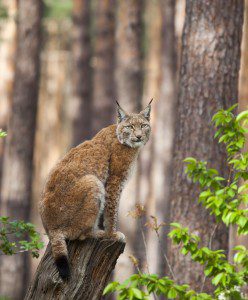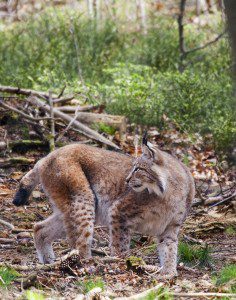
Wild Lynx could be reintroduce to counties south of the border neighboring Dumfries and Galloway by Next year to control the growing wild deer population.
Earlier this year, the Lynx UK Trust asked the general public for their opinion on bringing back the deer-hunting lynx after a 1,300 year absence to help balance out deer overpopulation and its damaging effects on forestry and agricultural crops. Over 9,000 people responded, the largest ever response to such a survey, recording support of up to 91% in favour of reintroduction.
Suggesting trial reintroduction sites in Aberdeenshire, Argyll, Northumberland, Cumbria and Norfolk, the Trust are now advancing through the penultimate stages of the application process with a national stakeholder consultation to formally discuss the details of reintroduction, and what it may mean for UK ecology and industries including tourism, farming and conservation.
The consultation includes the release of a document detailing the process of the consultation, the logistics of reintroduction and detailed assessments of the various impacts the lynx would be likely to have on life in the UK.
The document cites a range of independent research drawn from across the UK and Europe finding risks to be close to non-existent; lynx are no threat to people and are little to no threat for pets or livestock, however, they are very likely to provide benefits for various endangered species, deliver a hugely beneficial impact to forestry and crop farming through deer control and create substantial eco-tourism and job creation opportunities.
“We’re incredibly excited to start discussing the details with stakeholders.” comments Lynx UK Trust chief scientist, Dr. Paul O’Donoghue, “Lynx reintroduction is a big step for all of us in the UK and this is the opportunity for a wide range of groups to really understand what it could mean, how they could be affected, and to tell us and the statutory agencies how they feel about it.

“This consultation document, and the research it quotes, makes an overwhelmingly strong case for reintroduction of these amazing cats; they fit into the modern UK environment beautifully and can deliver a huge range of benefits for all of us, but of course we have to get the process right; this is a unique and ever evolving project and we really want to get stakeholders involved in helping to shape it. Beyond the national and local consultations we’ll be formally requesting licences to reintroduce, so the coming months are the opportunity for everyone to engage with the process and have their say on how this proceeds.”
The consultation cites independent research from infrastructure and environmental services consultancy AECOM, concluding that lynx reintroduction could deliver significant benefits including bringing millions of pounds into the UK economy from eco-tourism, creating hundreds of new jobs, and helping crop farmers and forestry businesses save hundreds of thousands of pounds every year through reductions in deer damage.
AECOM’s report analyses a wide range of data from across Europe, applying economic modelling and analysis to understand the many effects of lynx reintroduction, considering a full range of economic scenarios, from worst case to best case, as well as the most likely outcomes. In all instances, the reintroduction of lynx was found to deliver significant benefits.
Chris White, senior environmental economist at AECOM, said: “Our cost-benefit analysis shows that the argument for reintroducing lynx to the UK is compelling from an economic, social and environmental perspective. At a time when the UK needs to think laterally and creatively to realise economic benefits, this is an idea that should be fully explored, especially for the potential eco-tourism and job opportunities in rural communities.”
Stakeholders including landowners, farmers, gamekeepers and conservation groups have been invited to join the consultation, offer opinions and ask questions to help further detail reintroduction plans and provide statutory agencies such as Scottish Natural Heritage and Natural England with a detailed understanding of opinion.
Roger Leese, partner at international law firm Clifford Chance which is advising the Trust comments; “The potential benefits that these cats can bring are remarkable and, for a project such as this to move forward successfully, a detailed stakeholder consultation is a critical step required by EU law. Our team has been working hard to ensure the consultation meets all of the complex legal requirements and that no stone is left unturned. We look forward to the progressive discussions that will follow receipt of initial stakeholder feedback.”
The consultation will run until the new year at a national level, moving onto more detailed consultations at a local level in areas where trial reintroductions are planned in the new year.
More information will be available from www.lynxuk.org/consultation from Wednesday 28th October, including access to the Lynx UK Trust consultation documents and AECOM research documents.
Main Photo cub-by-Neville-Buck






